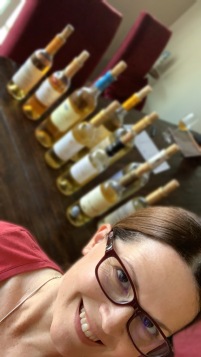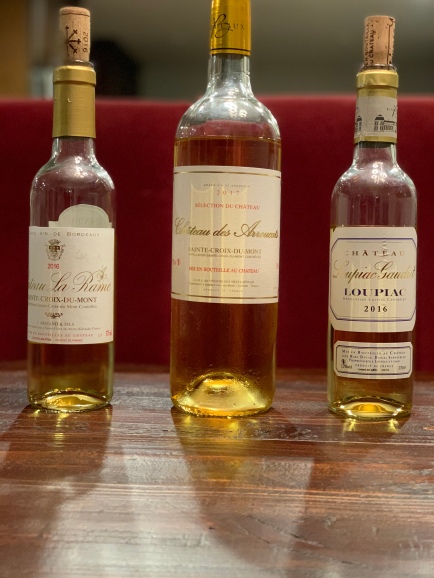Last month I had the opportunity to participate in my first virtual wine tasting with Snooth media. When they reached out to me about the theme of the tasting – the sweet wines of Bordeaux – I was thrilled. I have a soft spot (or should I say “sweet spot”?) for these wines. They are some of the most labor intensive wines produced in the world – and, unfortunately, some of the most misunderstood.
Sweet wines aren’t very popular with the modern day wine consumer. Perhaps its because we had a bad experience with a “sweet wine” early in our drinking days (I’m looking at you Boone’s Farm). Or perhaps its because we erroneously associate “sweet” with a drink that’s overly sugary and cloying.
Sweet Bordeaux wines are naturally sweet and balanced with a refreshing acidity. To develop these natural sugars, grapes require a very specific type of environment that only a few areas of the world can provide. Taking into account all the time and effort that goes into production, sweet Bordeaux wines are also an incredible value – not one of the bottles we received was over $40.
These wines are incredibly versatile and can be enjoyed with, or without, food. Instead of the usual sparkling wine, sweet Bordeaux wines would be a unique and memorable way to welcome your holiday guests. These wines are delicious with a wide range of foods – try them with spicy dishes as the sweetness tends to balance some of the heat. And they’re perfect for “Thanksgiving halftime” – after dinner is done, but before dessert is served.
The virtual tasting was hosted by Snooth Media and Master of Wine Jean K. Reilly. The text feed and video of the tasting can be found here. But before I go over my tasting notes, let’s take a brief look at Bordeaux – its history, varieties grown and why they’re able to produce such delicious sweet wines.
Bordeaux: A Bit of Background.
In 1453, at the conclusion of the Hundred Years’ War (fun fact: actually 116 years), the French reclaimed the Bordeaux region from the British. Shortly thereafter they began exporting wine to the Netherlands. The Dutch quickly became Bordeaux’s dominant trading partner – but they wanted white wine and sweet whites, as opposed to the red “claret” that had been so popular with the British for centuries.
From 1670 to the 1970s, Bordeaux produced more white wine than red. Today, however, red wine accounts for about 90% of Bordeaux production. Sweet wine production is decreasing due to falling consumer demand for this style.
Bordeaux sweet wines are produced from three grape varieties:
- Sémillon – usually dominates the blend, but its acreage is shrinking due to the decreasing popularity of sweet wines. Sémillon adds notes of tropical fruit, honey, apricot and nectarine as well as a lanolin-like texture.
- Sauvignon Blanc – provides zesty notes of citrus and grapefruit and refreshing acidity.
- Muscadelle – a small percentage of this variety (5% or less) is added to sweet wines to boost aromatics.
The overall climate of Bordeaux is maritime – it is strongly influenced by several bodies of water including the Atlantic Ocean, the Gironde Estuary, and the Dordogne and Garonne rivers. The region receives an abundance of rainfall (about 35 inches annually). Bordeaux’s sweet wine AOCs are clustered in one specific area within the region. And there’s a noble reason for this.
The most desired sweet wines are produced from grapes that have been affected by the fungus Botrytis cinerea – aka, “noble rot”. Noble rot requires specific conditions to develop: (1) fully ripe grapes, and (2) humid, misty mornings followed by sunny, dry afternoons.
In Bordeaux, at the confluence of the Ciron and Garonne rivers, cold water mingles with warm to create morning mists. The warmth of the region’s afternoon sun burns off this mist and keeps noble rot from developing into grey rot (which is the evil stepsibling of noble rot – it can destroy crops). The noble rot fungus grows on the grapes and penetrates the skins – feeding off of water, sugar and acids inside the berry. During this process, water content is reduced by half while acids, sugars and flavors are concentrated.
Hand harvesting these nobly rotted grapes can extend over a period of 4-8 weeks and requires multiple passes through the vineyards. As a general rule, one vine’s worth of botrytized grapes results in 1-3 glasses of wine. Botrytized grapes have ten times (!!) the normal number of aromatic compounds – resulting in wines with intense aromas of pineapple, honey, apricot and dried fruit.
Bordeaux: The Tasting.
We tasted through 11 (!) bottles of sweet Bordeaux during the virtual tasting. Many are available in the United States and would be lovely wines to serve, share or gift during the holidays. Seven of these bottles come in a handy 375mL size – and I think this is key to winning over new consumers. It’s challenging to commit to purchasing a standard sized bottle of something you’re not familiar with or unsure of whether or not you’ll like. Below are my tasting notes as well as prices and bottle sizes.
Disclaimer: All wines below were provided as media samples for the Snooth Virtual Tasting. Tasting notes and opinions are my own. 
1. Château de Marsan 2017 Bordeaux Moelleux, 11% abv (not currently imported)
80% Semillon, 20% Sauvignon Blanc
Notes: Surprised me that this is only 20% Sauvignon Blanc. Tastes like pink grapefruit with dash of sugar sprinkled on top. Has herbal qualities that the other wines don’t seem to have. Acidity is a bit lower too – and just a touch of sweetness. Pleasant and easy-drinking.
2. Château Majoureau 2018 Côtes de Bordeaux Saint-Macaire Doux, 12% abv (not currently imported)
90% Semillon, 10% Sauvignon Blanc
Notes: Aromas are fairly faint, and a bit more floral and spicy than honeyed fruit. On the palate – apples and spice, reminds me of a thick, rich apple cider. Compared to the other wines in the lineup, this wine is rather simple. Makes me wonder if it’s a bit too young at this point?
3. Château de Marsan 2015 Premiéres Côtes de Bordeaux Moelleux, 12% abv ($40) 80% Semillon, 15% Sauvignon Blanc, 5% Muscadelle
Notes: Ripe tropical fruits – mango and pineapple. Crisp acidity balances out the sweetness (the acidity actually seemed to fade after the glass had been sitting out and warming up – so my advice is to drink fast or pour less in your glass!). Lengthy, spicy finish.
4. Château des Arroucats 2017 Sainte-Croix-du-Mont, 13.5% abv ($14)
92% Semillon, 8% Sauvignon Blanc
Notes: Honeysuckle, beeswax and spiced pear. I want to say this is almost gravelly . . . so I’m going to: this is gravelly! Rich and luscious but with great acidity. Spicy finish. I had to go back and double check the price on this one – what an insane value!! This is in my top 3 of the lineup.

5. Château Loupiac Gaudiet 2016 Loupiac, 13% abv ($17/375mL)
Semillon/Sauvignon Blanc
Notes: Gorgeous golden color, aromas of honey, candied ginger, orange marmalade. Fuller bodied with an oily texture. Slightly nutty on the palate with flavors of hazelnuts and apricots. Bright acidity balances out the sweetness. This is also one of my favorites of the lineup – balanced, complex, lengthy finish – and delicious!
6. Château Ségur du Cros 2018 Loupiac, 13.5% abv (not currently imported)
85% Semillon, 10% Sauvignon Blanc, 5% Muscadelle
Notes: Milder aromas – but wow on the palate! Intensely flavorful and loaded with tropical fruits like mango and pineapple. Super fruity, balanced by refreshing acidity, with some candied ginger emerging as it warmed up in the glass.
7. Château La Rame 2016 Sainte-Croix-Du-Mont, 13% abv ($30/375mL)
75% Sémillon, 25% Sauvignon Blanc
Notes: Delicious aromas of peach nectar, honeysuckle, nuts, and orange marmalade. On the palate – quite viscous and a warming sensation (makes me feel like this is more than 13% abv, but still in balance). Long finish with a dash of spice at the end. One of my favorites!
8. Château du Cros 2016 Loupiac, 13.5% abv ($21/375mL)
90% Semillon, 10% Sauvignon Blanc
Notes: this wine smelled off/funky ☹ So, since the bottle was faulty, I won’t opine on the wine.
9. Château Costeau 2016 Cadillac, 13.5% abv ($18)
Semillon/Sauvignon Blanc
Notes: Medium gold color. On the nose there’s spice, ginger, toasted nuts and orange peel. And even though this descriptor is frowned upon – I’d call this sweet wine more masculine, almost smoky.
10. Château Dauphiné-Rondillon 2009 Loupiac, 13.5% abv ($23/375mL)
80% Semillon, 20% Sauvignon Blanc
Notes: Medium gold color. Loads of tertiary aromas like caramel and hazelnuts. Holy moly this is luscious!! Rich, full bodied. I’m getting some oak on this too – like burnt toast. Acidity is slightly diminished (understandable – this is 10 years old). Like most old wines, I can appreciate this – but it’s not my favorite. I prefer the younger, fresher styles (Hubs IS a whopping 7 months younger than me after all!) 😉
 11. Château du Pavillon 2002 Sainte-Croix-du-Mont, 13% abv (not currently imported) 80% Semillon, 18% Sauvignon Blanc, 2% Muscadelle
11. Château du Pavillon 2002 Sainte-Croix-du-Mont, 13% abv (not currently imported) 80% Semillon, 18% Sauvignon Blanc, 2% Muscadelle
Check out the aged cork on this one! Tertiary aromas of caramel, nuts and graham cracker. (And am I imagining marshmallow crème aromas because of the graham cracker?!) The nose on this is just delicious. Similar flavors on the palate – with some expected diminished acidity from ageing.
As mentioned earlier, one vine of botrytized grapes produces only 1-3 glasses of wine. There is so much time, energy and effort that go into producing just ONE bottle of sweet Bordeaux. Likewise, there is a lot of time, energy and effort expended by most people during the holidays. We stress out to find the perfect gift, to cook a delicious meal, to be the consummate hostess or to attend the umpteenth obligatory holiday party.
What if instead of madly running around and fighting traffic (or fighting family members), we took some time to just leisurely enjoy a wine that simply can’t be rushed. These wines are produced slowly – the development of noble rot and weeks of hand harvesting cannot be hurried along. They take their sweet time. 😉 Bordeaux sweet wines are a perfect way to slow down, and savor, your holidays.
I enjoyed my first white Bordeaux at Thanksgiving. I was pleasantly surprised at how smooth it was. I wish I had remembered to take a picture of the label. I think I was in a food coma.
LikeLiked by 1 person
Haha! Food comas are always a good excuse! 😉 Glad you enjoyed it – they can be really delicious (and reasonably $$!)
LikeLike